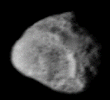Saturn, the second largest planet in the solar system, has roughly 764 times the volume of earth and is 95 times more massive. Its overall composition like Jupiterís is mostly hydrogen and helium, with methane, ammonia, and ethane in the upper atmosphere. The colors in the atmosphere are not as brilliant as on Jupiter, and it is harder to see the features. This is because Saturn is colder, and a layer of white ammonia clouds blocks our view. Saturnís interior is probably very similar to that of Jupiter.
Like Jupiter, Saturn gives off a lot more heat than it receives from the sun. Scientists believe that this is because the helium, which is heavier than hydrogen, is raining out of the atmosphere and sinking to the core, releasing heat. In essence, Saturn is still forming!
Although all of the gas giants have ring, Saturnís rings are the largest. Saturnís rings start near the top of Saturnís atmosphere and extend out 136,000 km, yet they are only a few hundred meters thick. The rings consist of icy particles that range in size from a few cm to several meters across |














